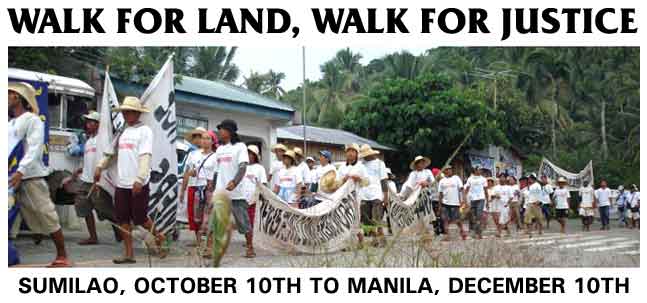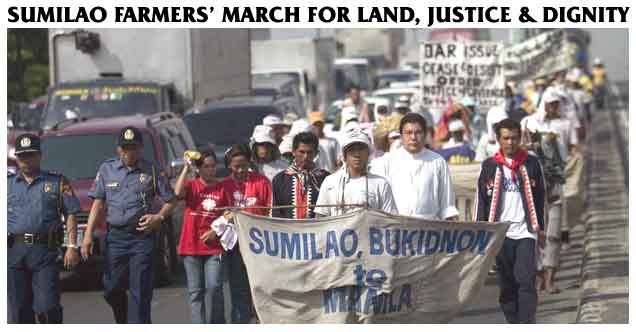
The Higaonon Indigenous Cultural Communities were the early settlers of a piece of ancestral land in Sumilao, Bukidnon. The 855 hectare ancestral land served as the Seat of Government of the Higaonons where the traditional “paghusay” (conflict resolution) and “pamuhat” (rituals) were conducted by the Higaonon tribal council lead by Apo Manuagay Anlicao and Apo Mangganiahon Anlicao. The ancestral land is a flat agricultural terrain situated in the midst of Mt. Sayawan and Mt. Palaopao, and where Mt. Kitanglad can be seen from afar. It was once termed as pinetreehon by the visitors due to the abundance of pine trees all over the place and its cold temperature. Magbabaya gave this “balaang yuta” to the Higaonon communities. It was their foreparents’.
Then the Angeles came in 1940s forcibly evicting the Higaonons from a 243.8551 hectare portion of their ancestral land and converted it into a cattle ranch. The land was later transferred to the Ilagans. In 1970s, the ancestral land was divided between two landowners: 99.8551 hectares to Salvador Carlos while the 144 hectares was transferred to Norberto Quisumbing through the Norberto Quisumbing Sr. Management and Development Corporation (NQSRMDC). The ancestral land was eventually leased to Del Monte Philippines, Inc. (DMPI) for 10 years until 1994. At that time, the Higaonons became farmworkers of the land they once owned.
— Full text of position paper available at http://sumilaomarch.multiply.com/
One hundred and sixty-five farmers from Sumilao, Bukidnon have been struggling for their right to food for the past 10 years. Although the farmers were identified as beneficiaries for 144 hectares of land in 1995, the land was later converted from agricultural to agro-industrial use, thus exempted from the national agrarian reform program. On October 10, 50 Sumilao farmers started a march from Sumilao to Manila, a distance of 1500 km, to bring their case to the Department of Agrarian Reform and the Office of the President in time for the International Human Rights Day (December 10).
Background
Bukidnon, a province in the Northern Mindanao region, is known in the Philippines as the food basket of Mindanao. The province is a major producer of rice, maize, coffee, pineapple and other fruits and vegetables, as well as chickens, hogs and cattle.
For the past 10 years, the farmers from Sumilao, Bukidnon have been struggling for their right to food. In 1990, the 144-hectare Quisumbing Estate was placed under the national agrarian reform program, the Comprehensive Agrarian Reform Program (CARP). One hundred and sixty-five farmers were identified as farmer beneficiaries and awarded a Certificate of Land Ownership Award (CLOA) by the Department of Agrarian Reform (DAR) in 1995. However, the land was never distributed to them and the farmers were not able to till the land to feed themselves adequately. Shortly after the farmers received the CLOA, the landowner applied to convert the 144 hectare land from agricultural to agro-industrial use and establish the Bukidnon Agro-industrial Development Area (BAIDA) notwithstanding the fact that prime agricultural lands are non-negotiable for conversion. While the conversion application was originally denied by the DAR Central Office, it was later approved by the Office of the President, Executive Secretary Ruben Torres, despite its illegality.
Deprived of their means to feed themselves, the farmers occupied the said landholding and began cultivating. The landowner retaliated by sending armed guards who harassed the farmers and destroyed their huts. Left with no more recourse, the farmers decided to stage hunger strikes in front of the DAR Central Office in Manila, consuming nothing but water for 28 days. Due to huge public pressure, then President Ramos issued a resolution wherein 100 hectares were to be given to the farmers and the rest to the landowner Norberto Quisumbing. Infuriated with this decision, however, Quisumbing brought the same before the Supreme Court and the court reinstated the earlier ruling in favour of the landowner. This was in 1999.
Then in 2002, the landowner sold the 144 hectare land to San Miguel Foods, Inc (SMFI), the largest conglomerate in the Philippines which plans to put up a piggery farm. None of the projects upon which the conversion was conditioned were implemented. In 2004, the Sumilao farmers filed a petition for the cancellation of the conversion order against Quisumbing and/or SMFI before the DAR on the basis that Quisumbing has failed to initiate any development work on the land, and that SMFI violated the conditions of the conversion order by changing completely its use to hog farming. The case was then brought to the Office of the President and it is currently pending. Recently, the farmers decided to stage a march of 60 days from Sumilao to Manila. They hope to reach Manila on 3rd of December, in time for the Human Rights Week Celebration, to resolve the claim on the 144 hectares that are rightfully theirs.
The Mandate of the Emergency Network
The Philippines is a state party to the International Covenant on Economic, Social and Cultural Rights and is therefore duty-bound under international law to fulfil the right to food of its population. Agrarian reform is a central measure to implement the landless farmers’ right to feed themselves and hence obligatory. The failure to install the 165 identified farmers’ beneficiaries onto the 144 hectare landholding and the related irregularities with respect to the land conversion constitute a breach of this obligation. Hence the government of the Philippines has violated the peasants’ right to feed themselves.
Action
Please write a polite letter to President Gloria Macapagal-Arroyo as well as to Secretary Nasser C. Pangandaman, Department of Agrarian Reform, requesting them to immediately distribute and install the 165 farmer beneficiaries and their families to the said landholding.
Ten years ago, 15 farmers of the Mapadayong Panaghiusa Sa Mga Lumad Alang Sa Damplag (MAPALAD) of Sumilao, Bukidnon came to Manila for a 28-day hunger strike at the Department of Agrarian (DAR) office in Quezon City. To this day, barred by electric fences and armed security, they remain outsiders to their own land.
The Sumilao farmers are again demanding that the conversion order be cancelled, and the land that is rightfully theirs returned. On 10th October 2007, 10 years since their first mass protest in Manila, they began a 60-day ‘March for Land’ from Mindanao to Visayas and Luzon joined by other farmers from the regions. With this plea for land ownership to President Gloria Macapagal-Arroyo is an appeal for the passage of HB 1257, a bill to extend and reform the current Comprehensive Agrarian Reform Program (CARP), so that no other Filipino farmer may suffer as they have.
As legal co-counsel to the Sumilao farmers and co-drafters of HB 1257, SALIGAN believes in this fight, and that it could be won with you in it.
You may take part in this historic campaign in the following ways:
Visit sumilaomarch.multiply.com or e-mail saliganphilippines@gmail.com for more information.
“Today we end this journey of 1,700 kilometers, but the journey towards achieving our 144-hectare land continues. Should the government fail to live up and make good its promises, we are willing to retrace our steps from Sumilao back to Malacañang, we are even ready to make sacrifices beyond that.” —Sumilao Farmers’ Manifesto, 21 December 2007

See also:
 Home | Aims and Objectives of Solidarity Philippines Australia Network | About Kasama
Home | Aims and Objectives of Solidarity Philippines Australia Network | About Kasama 
Search the SPAN Web